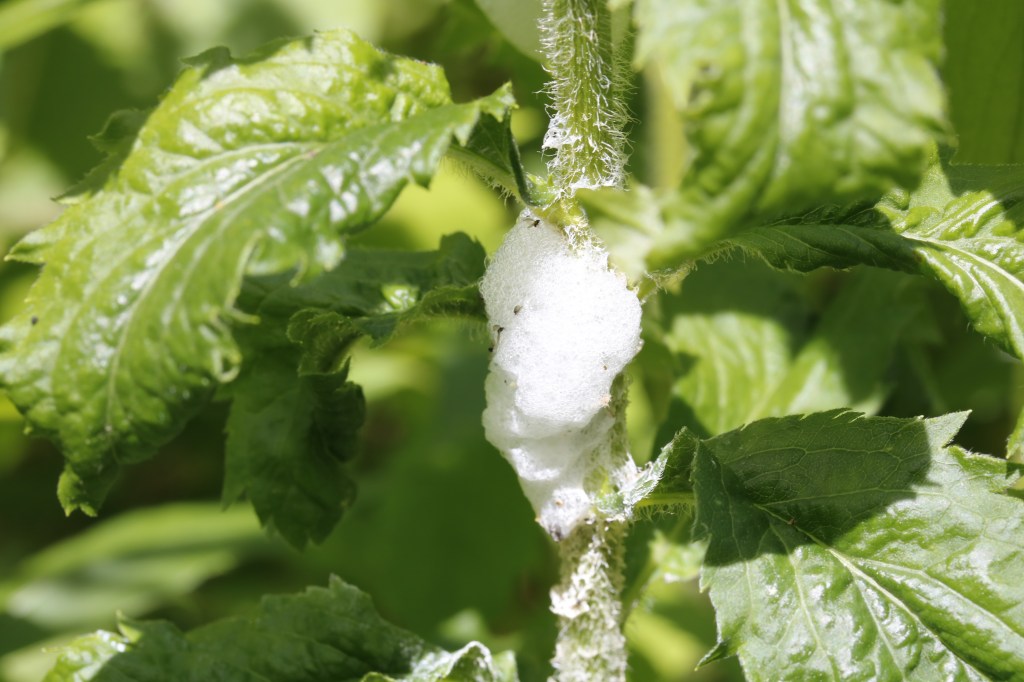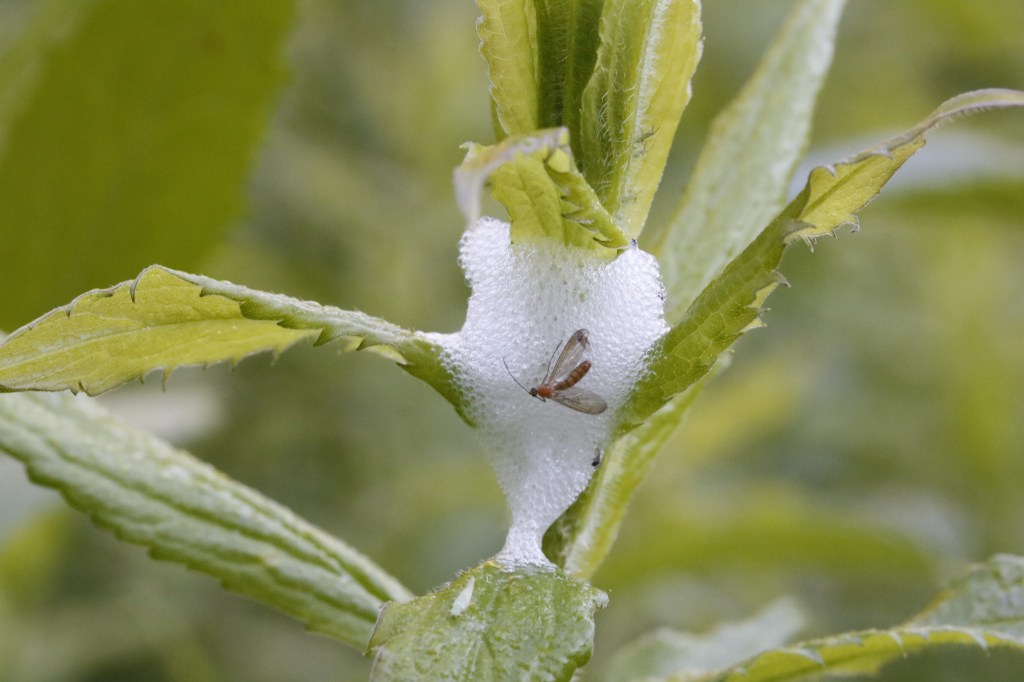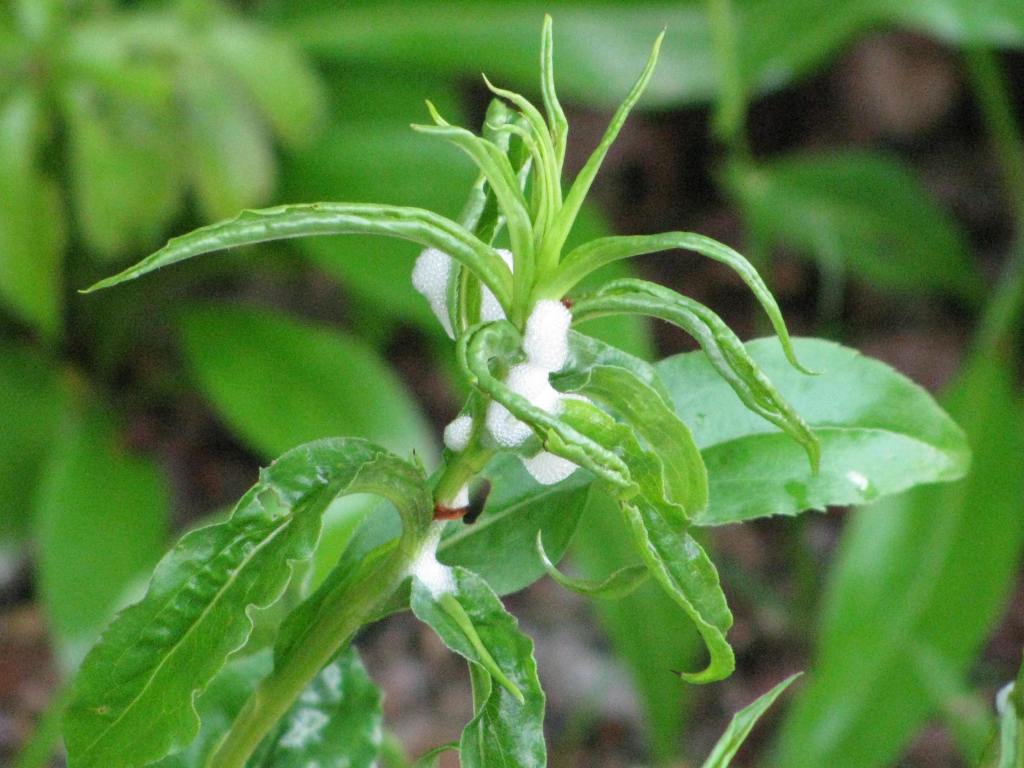
In some northeastern states, this is the time of year when white froth can be found on the stems of goldenrods and other plants. The froth is a bunch of persistent bubbles hanging precariously on the plants, yet more firmly than we might think possible. Within each mass is the nymph of a cercopid (family Cercopidae, Order Hemiptera), aka froghopper, aka (crudely, but also evocatively) spittlebug.
The nymphs suck fluids from the vascular tissue of the plant, receiving far more water than they need. Nitrogen and other nutrients are so dilute that the nymphs have to process a lot of water to meet their requirements. While other types of sucking bugs dump the water with less fanfare, cercopid nymphs add something to it to generate the frothy, spittle-like globs. Their waste ends up as defense against enemies, and against dehydration from living on the outside of plant stems.
Peter McEvoy examined and experimentally moved the nymphs of two species of spittlebugs in old fields near Ithaca, NY. They tended to prefer to feed (and froth) in the leaf axils (where a leaf joins the stem) instead of on the plain stem between leaves, and preferred wider axils over narrow axils. And on goldenrods, they preferred to be near the apex of the plant. Their food is quite dilute, but perhaps more nutritious in some locations than others. And their defensive spittle is more likely to be successful when supported by parts of the plant and not merely hanging insecurely from a bare stem.
I am not sure how these nymphs are able to breathe from inside their masses of bubbles, but they obviously can. The spittle is visually conspicuous on their host plants, but that doesn’t seem to be a problem. The spittle is also quite gross to the touch, apparently a deterrent to an array of predators, large to small. Thus defended, cercopids can be quite abundant on herbaceous plants, and goldenrods are among their favored hosts. Yet there are still far more leaf axils than spittlebugs, so feeding locations do not appear to be restricting the abundance of nymphs. Something else seems to be keeping their numbers in check.

This fly landed in a bad place, got stuck in the spittle, and died. No, the nymphs are not predators. Their defenses are just too much for some delicate neighbors.
The adults do not produce spittle, but instead depend on hopping and flying to escape danger. Years ago, I found a fair number of adults feeding on goldenrods and other plants in the latter part of summer. At some point, they mated, laid eggs, and (having initiated the next generation) died. I will watch for the adults this year, and if I can get a photo, I will post it. Don’t hold your breath. The adults are not nearly as conspicuous as the bright white batches of bubbles they inhabit in their youth.
Peter B. McEvoy 1986 Niche partitioning in spittlebugs (Homoptera: Cercopidae) sharing shelters on host plants. Ecology 67: 465-478
https://esajournals.onlinelibrary.wiley.com/doi/abs/10.2307/1938590


June 19, 2021 at 6:48 pm
Fascinating!!!
LikeLike
June 19, 2021 at 7:34 pm
Yes, they are! So common, yet so strange.
LikeLike
June 21, 2021 at 9:03 am
Interesting article—I’ve noticed Spittlebug bubbles often. Why “Froghoppers”? To they hop like frogs or jump on on frogs? Todd says there is a classic study on genetic diversity in Spittlebugs from the islands off Finland proving the more remote the less diversity. Sounds easier than studying finches in the Galapagos.
LikeLiked by 1 person
June 21, 2021 at 10:06 am
I have no idea how the name originated. There is another family of toad bugs, but they look nothing like cercopids. I will have to look for the Finnish study!
LikeLike